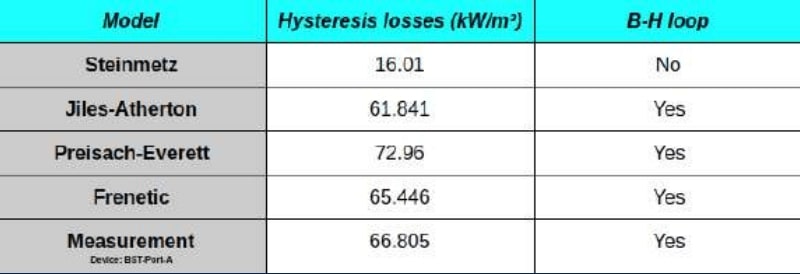Core losses calculation problems
Comparison of a new hysteresis losses calculation method versus three other classical models.
At Frenetic we propose a new method for predicting ferrite properties. In this app note we will compare this new method with three other classical models for calculating hysteresis losses. These models have good accuracy in the frequency range from 50 kHz to 300 kHz, but have poor performance outside, mainly because of harmonics or closeness to the saturation zone. In this application note, the results are shown.
Steinmetz Model:

Pros: Coefficients provided by the manufacturers. Easy implementation.
Cons: Inaccurate for waveforms with high harmonic content. DC magnetization is not taken into account.
Jiles-Atherton Model:

Pros: Easy implementation and quick computing. Better than Steinmetz's with harmonics.
Cons: Not all manufacturers give the parameters. Poor accuracy near saturation.
Preisach-Everett Model:

Pros: Good accuracy over a wide frequency range. Works well with non-sinusoidal waveforms.
Cons: Need to calculate the Preisach coefficients and material parameters. Heavy computing.
Frenetic Model:

Pros: Good accuracy over a wide frequency range. Works well with non-sinusoidal waveforms.
Cons: Few data points given by manufacturers.


Case of study:
AL= 2500 nH le= 62.83 mm Rw= 16.5 mΩ Material= 3F36FXC Turns= 10 Freq= 10 kHz Ve= 3141.59 mm³ L= 250 µH Shape= T25/15/10 Wire= Round 18 AWG Temp= 25 ℃
The results given by Frenetic's Artificial Intelligence show a lower error rate.
The results given by the Artificial Intelligence keep the error rate low (~2%, much lower than the other models) due to its intrinsic understanding of the non-linearities existing in the materials (in this case in a low-frequency range), in addition to the blending of measurements and analytical models from which it learns. Predicting power losses with such high accuracy enables engineers to optimize the design of magnetic components by letting them get closer to the working limits of the materials, resulting in more compact and efficient power systems.
Do you want the full version?
Login or Signup for our newsletter!
